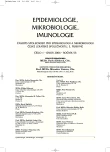-
Medical journals
- Career
Methods for Detection of Biofilm Formation in Routine Microbiological Practice
Authors: F. Růžička; V. Holá; M. Votava
Authors‘ workplace: Mikrobiologický ústav Lékařské fakulty a Fakultní nemocnice u sv. Anny v Brně
Published in: Epidemiol. Mikrobiol. Imunol. 55, 2006, č. 1, s. 23-29
Overview
The increasing use of catheters, artificial implants and antimicrobials as well as high numbers of immunocompromised patients are major causes for concern over biofilm infections. These infections are characterized particularly by high resistance to antimicrobials and formation of persistent foci that may complicate therapy. Therefore, detection of biofilm formation is of high relevance to the clinician and his/her approach to the treatment. Reliable and sensitive methods for detection of this pathogenicity factor in clinically important organisms, suitable for use in routine microbiological laboratories, are needed for this purpose. Currently, a wide array of techniques are available for detection of this virulence factor, such as biofilm visualization by microscopy, culture detection, detection of particular components, detection of physical and chemical differences between biofilm-positive organisms and their planktonic forms and detection of genes responsible for biofilm formation. Since each of these methods has limitations, the best results can be achieved by combining different approaches.
Key words:
biofilm – methods for biofilm detection – Christensen’s test tube method – Congo red agar – capillary zone electrophoresis – capillary isoelectric focusing
Labels
Hygiene and epidemiology Medical virology Clinical microbiology
Article was published inEpidemiology, Microbiology, Immunology

2006 Issue 1-
All articles in this issue
- Current Epidemiological and Clinical Issues Regarding Helicobacter pylori Infection in Childhood
- Current Prevalence of Toxocariasis and other Intestinal Parasitoses among Dogs in Bratislava
- Methods for Detection of Biofilm Formation in Routine Microbiological Practice
- Vibrio Cholerae 01 in a Fish Aquarium
- Diagnosis of Rotavirus Infections in 2004, Major Characteristics in 1998–2004 in the Czech Republic
- Comparison of Efficacy of the Rapid Mycobacteria Growth Indicator Tube (MGIT) Culture Method (Manual System) and Conventional Culture Method in Mycobacterial Detection
- Epidemiology, Microbiology, Immunology
- Journal archive
- Current issue
- Online only
- About the journal
Most read in this issue- Methods for Detection of Biofilm Formation in Routine Microbiological Practice
- Comparison of Efficacy of the Rapid Mycobacteria Growth Indicator Tube (MGIT) Culture Method (Manual System) and Conventional Culture Method in Mycobacterial Detection
- Current Prevalence of Toxocariasis and other Intestinal Parasitoses among Dogs in Bratislava
- Current Epidemiological and Clinical Issues Regarding Helicobacter pylori Infection in Childhood
Login#ADS_BOTTOM_SCRIPTS#Forgotten passwordEnter the email address that you registered with. We will send you instructions on how to set a new password.
- Career

